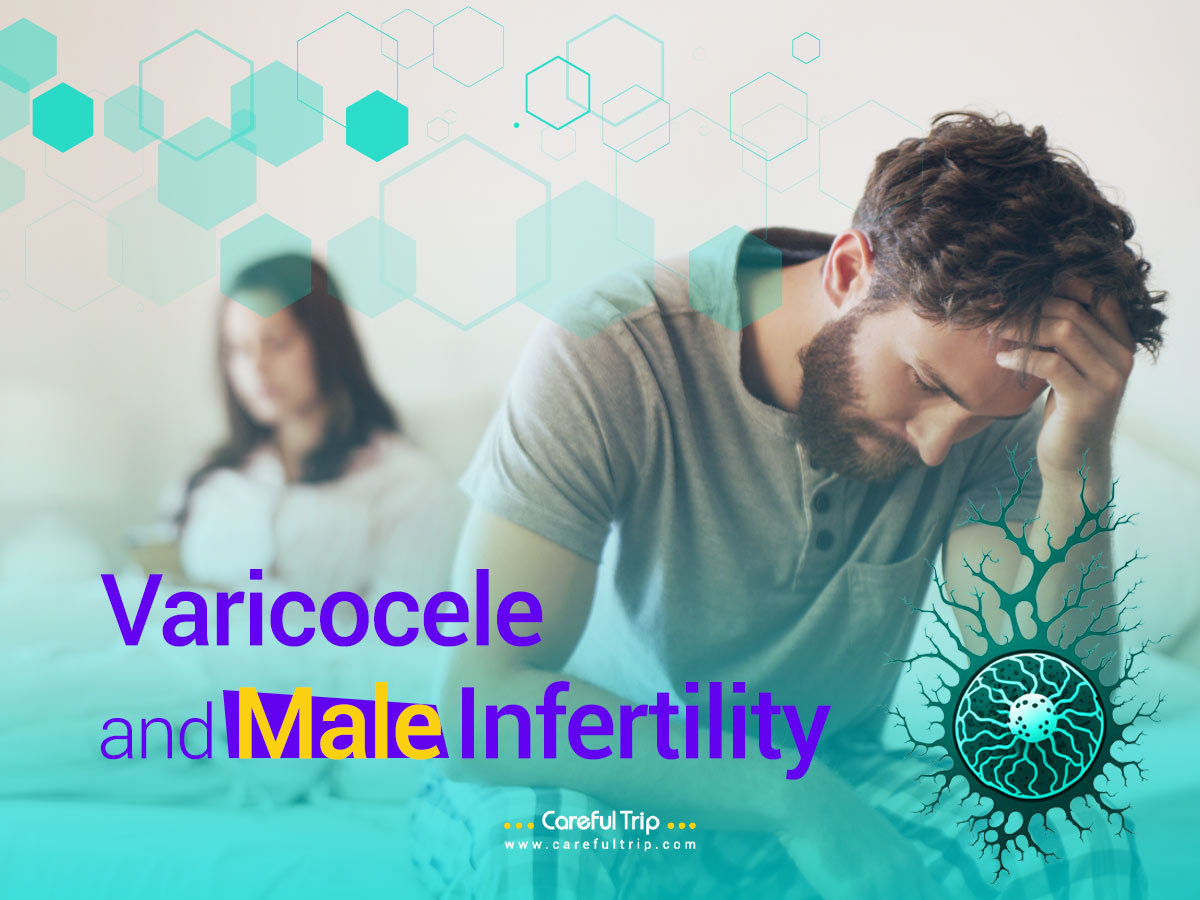
Varicocele is a common condition affecting the veins within the scrotum, analogous to varicose veins that occur in the legs. It is characterized by an abnormal enlargement of the pampiniform venous plexus in the scrotum, which can lead to a variety of symptoms and complications, including male infertility. Approximately, 10 percent of all men suffer from varicoceles and 30% of all men who suffer from infertility have it too, making it a prevalent issue among men, linking varicocele with male infertility.
There have been evidential studies done on the positive effect of varicocelectomy on sperm quality, function and pregnancy outcome. Here we discuss the varicocele ailment, its effect on male fertility and possible ways to combat it. What are the links between varicocele and male infertility and what should one who suffers from the ailment do?
Understanding Varicocele
Poor blood flow causes the veins in the scrotum to expand, a condition known as varicocele. The pampiniform plexus, a group of veins, is in charge of removing blood from the testicles. Blood collects in the scrotum due to malfunctioning valves in these veins, causing swelling and elevated pressure. This may result in discomfort and a variety of reproductive problems.
- Prevalence: Varicocele is a rather frequent condition that affects 15% of all males. The prevalence rises to roughly 35% in men with initial infertility and 80% in individuals with secondary infertility.
- Symptoms: A dull, painful discomfort in the scrotum is one of the main symptoms of varicocele in males, however many may not have any symptoms at all. This pain is often felt after extended standing or physical activity. As a result of tissue damage and reduced blood supply, the damaged testicle may appear smaller.
- Causes: Although the precise cause of varicocele is unknown, it is thought to be the result of malfunctioning valves in the spermatic cord’s veins. Vein dilatation and blood pooling result from this. Because the left and right sides of the scrotum have different anatomical venous drainage patterns, the disease is more frequently observed on the left side.
For more information, read:
Varicocele and Male Infertility
The link between varicocele and male infertility has been well documented. Varicocele can affect sperm production and quality, leading to difficulties in conceiving.
1. Mechanisms of Infertility:
Several mechanisms have been proposed to explain how varicocele affects fertility. These include:
- Increased Scrotal Temperature: Varicocele can cause the scrotum to become hotter, which has a detrimental effect on spermatogenesis, or the generation of eggs. Because the testicles naturally have a lower temperature than the rest of the body, good sperm production depends on this difference in temperature.
- Oxidative Stress: Varicocele can result in an increase in reactive oxygen species (ROS) generation, which can harm sperm membranes and DNA.
- Hormonal Imbalances: Varicocele-affected men may have changed testosterone and other reproductive hormone levels, which can affect sperm function and production.
- Hypoxia: Blood clotting and elevated venous pressure can cause hypoxia, or low oxygen delivery to the testicular tissues, which further hinders the creation of sperm.
2. Impact on Sperm Parameters:
Varicocele can lead to a range of abnormalities in sperm parameters, including:
- Decreased Sperm Count: Sperm counts in men with varicocele are frequently lower than in men without the illness.
- Reduced Sperm Motility: Sperm motility, or their ability to move and swim, might be greatly diminished, which can impact their capacity to reach and fertilize an egg.
- Morphological Abnormalities: Varicocele can result in a higher proportion of sperm with deviant morphologies and architecture, which lowers the likelihood of conception.
3. Diagnosis of Varicocele:
Diagnosis of varicocele typically involves a physical examination and scrotal ultrasound.
- Physical Examination: When conducting a physical examination, a medical professional can frequently identify a varicocele by palpating the patient’s scrotum while they are standing and using the Valsalva technique, which involves bearing down as though they are having a bowel movement.
- Scrotal Ultrasound: The presence and severity of a varicocele can be confirmed using an ultrasound, which can give a more thorough view of the veins and blood flow within the scrotum.
Treatment Options for Varicocele
For males who are experiencing pain, testicular atrophy, or infertility, treatment for varicocele is typically advised. There are numerous alternatives for treatment, both surgical and non-surgical.
1. Surgical Treatment:
The primary surgical treatment for varicocele is called varicocelectomy, which involves the ligation of the affected veins to redirect blood flow to healthy veins.
- Microsurgical Varicocelectomy: With this method, the surgeon can accurately identify and ligate the problematic veins with the use of a microscope. In comparison to other surgical techniques, it is linked to greater success rates and fewer problems.
- Laparoscopic Varicocelectomy: In this minimally invasive surgery, tiny incisions are made in the belly, and the veins are ligated under the guidance of a laparoscope.
- Embolization: A non-surgical procedure in which a radiologist places coils or a sclerosant agent in the afflicted veins using a catheter inserted into the neck or groyne, obstructing blood flow and causing the veins to shrink.
2. Non-Surgical Treatment:
In some cases, non-surgical treatments such as lifestyle changes and medications may be recommended.
- Lifestyle Modifications: Wearing supportive underwear, avoiding prolonged standing or heavy lifting, and applying ice packs to the scrotum can help manage symptoms.
- Medications: Anti-inflammatory medications may be prescribed to relieve pain and discomfort associated with varicocele.
Catheter-Directed Embolization
Catheter-directed embolization is a non-surgical, outpatient procedure performed by an interventional radiologist. The process involves using imaging to guide catheters or other instruments inside the body. Patients receive mild IV sedation and local anesthesia, ensuring they remain relaxed and pain-free during the approximately two-hour procedure.
The procedure begins with a small incision at the groin, made under local anesthesia. A thin catheter is then inserted into the femoral vein and directed to the testicular vein. Contrast dye is injected to visualize the veins and identify the problematic area for embolization. Using coils, balloons, or particles, the radiologist blocks the blood flow in the affected vein, reducing pressure on the varicocele and redirecting blood flow to healthier pathways. This internal “shut off” of the incompetent vein achieves the same results as surgical intervention without the need for surgery.
Efficacy of Embolization for Varicoceles
Embolization is as effective as surgical ligation in improving male infertility, with comparable costs. Studies show similar pregnancy and recurrence rates between embolization and surgical varicocelectomy. One study found that 60% of men treated for infertility conceived after embolization. Another study revealed that sperm concentration improved in 83% of patients undergoing embolization compared to 63% of those who had surgical ligation. Patients who experienced both procedures generally preferred embolization.
Outcomes and Prognosis
The prognosis for men undergoing varicocele treatment is generally positive, particularly for those seeking to improve fertility.
Fertility Outcomes: Varicocelectomy has been demonstrated in studies to considerably enhance sperm parameters and raise the chance of becoming pregnant, either naturally or with the use of assisted reproductive technologies (ART) like in vitro fertilization (IVF) or intrauterine insemination (IUI).
- Pregnancy Rates: Although there are differences in the success rates of getting pregnant following a varicocelectomy, numerous studies show that couples where the male spouse had the surgery had better success rates.
Testicular Function: Testicular function can be enhanced with surgical treatment of varicocele, including reduced testicular discomfort and greater production of testosterone.
Recovery Time for Varicocele Treatment
Recovery time for embolization averages one to two days, significantly shorter than the two to three weeks required for surgical recovery. Additionally, 24% of surgical ligation patients needed an overnight hospital stay, whereas embolization patients did not.
Benefits of Interventional Radiology Procedure
- No surgical incision in the scrotal area
- Effectiveness comparable to surgery, as measured by improvements in semen analysis and pregnancy rates
- Shorter recovery time, allowing patients to resume normal activities immediately and without hospital admittance
- Ability to treat bilateral varicoceles through a single vein puncture, unlike surgery, which requires two separate incisions
- No general anesthesia
- No sutures
- Lower risk of infection
- Cost-effective
Varicocele and Assisted Reproductive Technologies
For men with persistent infertility issues despite varicocele treatment, assisted reproductive technologies (ART) may be recommended.
- Intrauterine Insemination (IUI): Sperm is inserted directly into the uterus during IUI in order to promote conception. After varicocele treatment, it is frequently advised for couples in which one of the male partners has mild to moderate sperm abnormalities.
- In Vitro Fertilization (IVF): IVF is the process of fertilizing an egg outside the body with sperm and then placing the resultant embryo inside the uterus. Couples who have severe sperm abnormalities or who have not responded to prior therapies may try IVF.
- Intracytoplasmic Sperm Injection (ICSI): In ICSI, an egg is directly injected with a single sperm during the IVF process. Men with significant sperm abnormalities, such as those with low sperm motility or morphology, can benefit most from it.
Final Words
Varicocele is a common condition that can significantly impact male fertility. While the exact mechanisms by which varicocele affects fertility are not fully understood, increased scrotal temperature, oxidative stress, hormonal imbalances, and hypoxia are believed to play key roles. Diagnosis typically involves a physical examination and scrotal ultrasound, and treatment options include both surgical and non-surgical approaches.
Surgical treatment, particularly microsurgical varicocelectomy, has been shown to improve sperm parameters and increase pregnancy rates. For men who continue to experience infertility despite varicocele treatment, assisted reproductive technologies such as IUI and IVF offer additional pathways to achieving pregnancy. With proper diagnosis and treatment, many men with varicocele can improve their fertility and realize their dreams of fatherhood.
For men who are seeking treatment for their infertility, CarefulTrip agency provides them with free fertility-related consultation as they partner with the excellent expertise of the MOM Fertility Clinic. Offering some of the most competitive prices for fertility treatment, a fraction of the western countries, MOM Fertility Clinic doesn’t sacrifice their quality of care and CarefulTrip ensures that their patients are looked after and are provided, with caretakers, translators, and the best accommodation available. Contact us today!
For more information, read:
